Some Vietnamese Viewpoints upon Second Language Acquistion Theories in Language Contact Environment
This study focuses on the interference between the theories of second language acquisition by the native speakers
(such as: Behaviorist's theory, Nativist's theory, Interactionist's theory, Information Processing theory, Vygotsky's theory,
Halliday's theory, Sociolinguistic's theory) and the viewpoints of the non-native speakers (e.g. Vietnamese) who study a native
language (e.g. English) as a second language or foreign language. Moreover, based on the summary table of the second
language acquisition theories, the viewpoints of non-native speakers are analyzed to find out which theories adapt the
viewpoints of the learners, being really the ones who acquire second languages. Last but not least, the effects of learning
process and of learners on second language acquisition are explored for illustration.
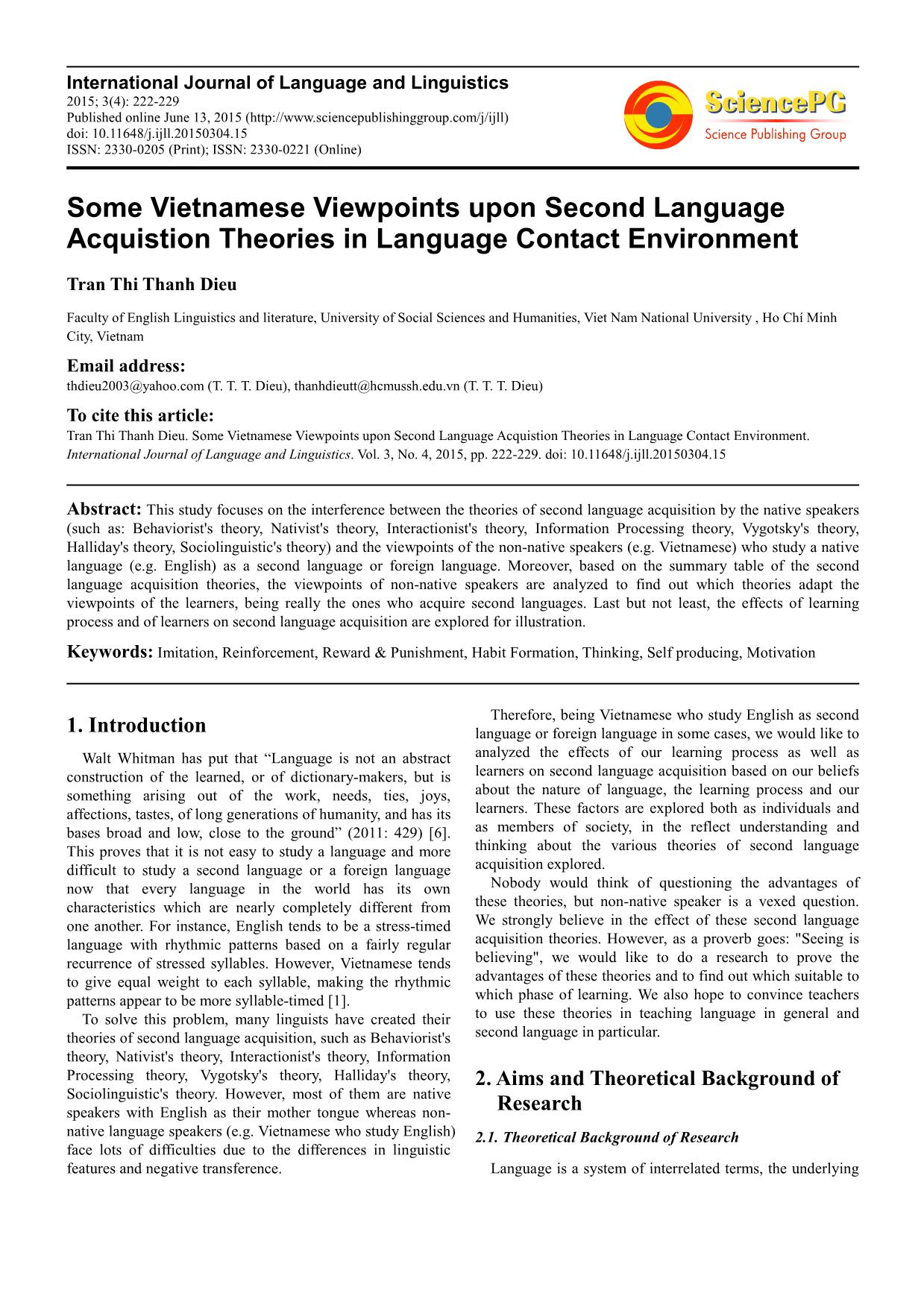
Trang 1
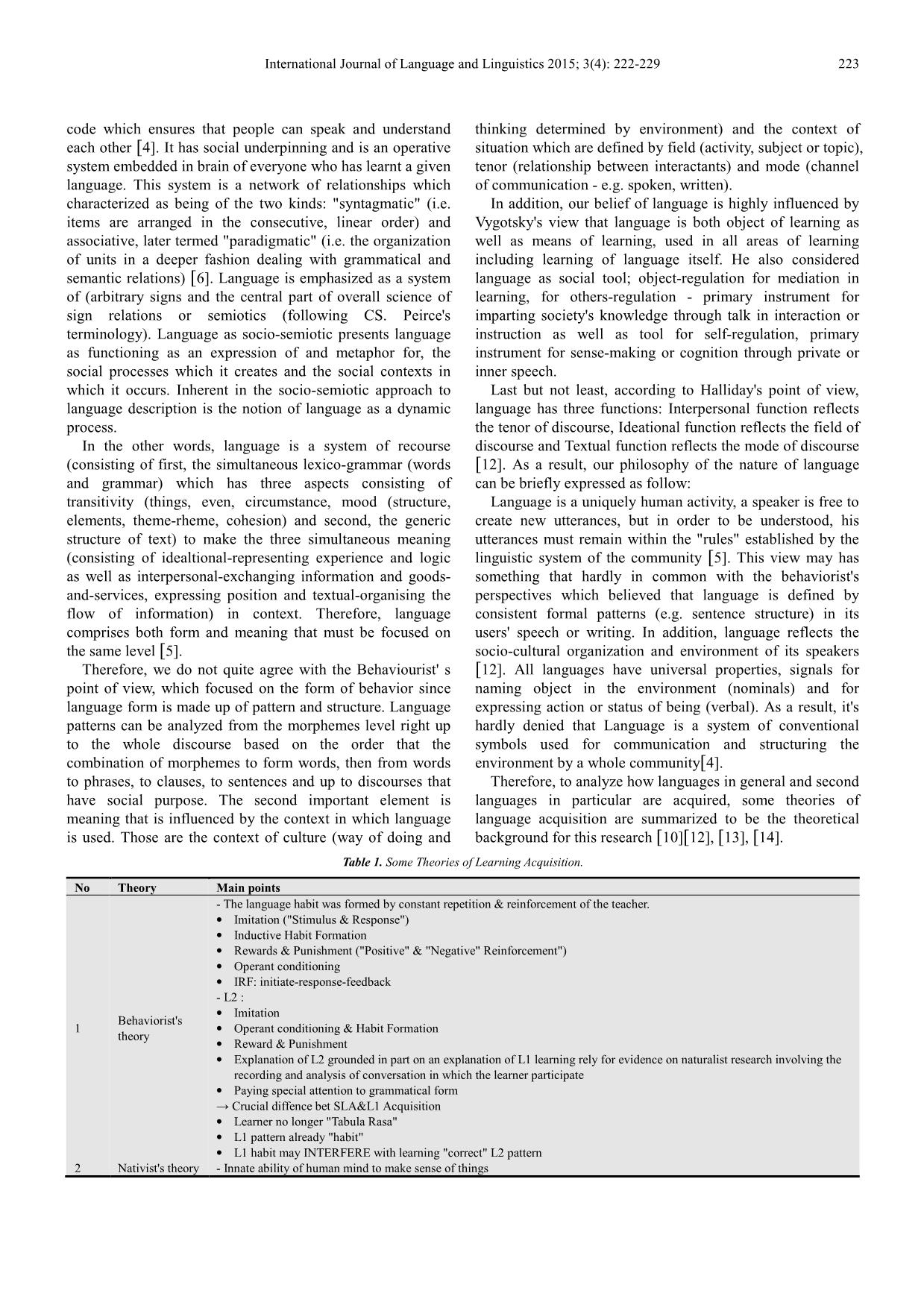
Trang 2
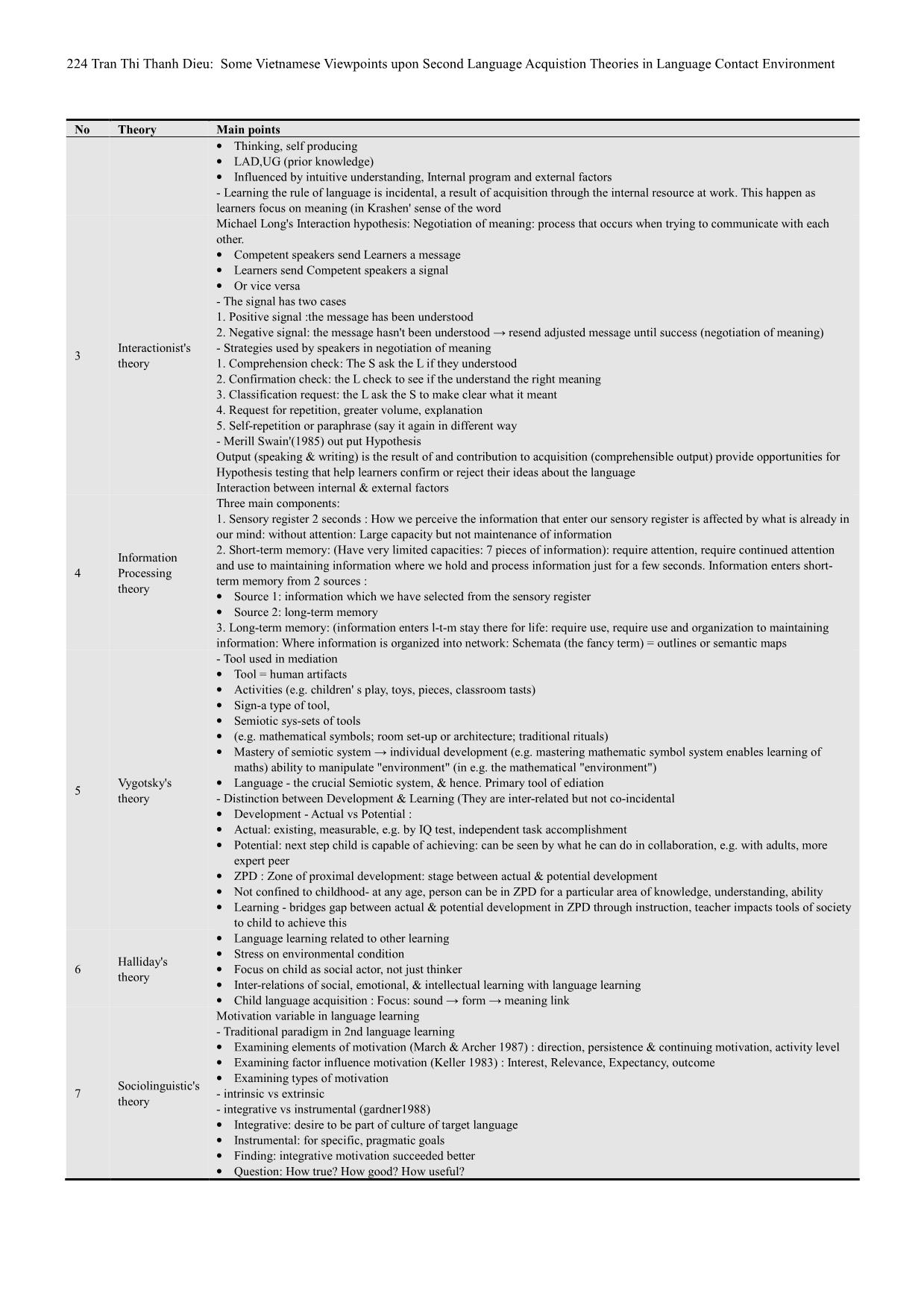
Trang 3
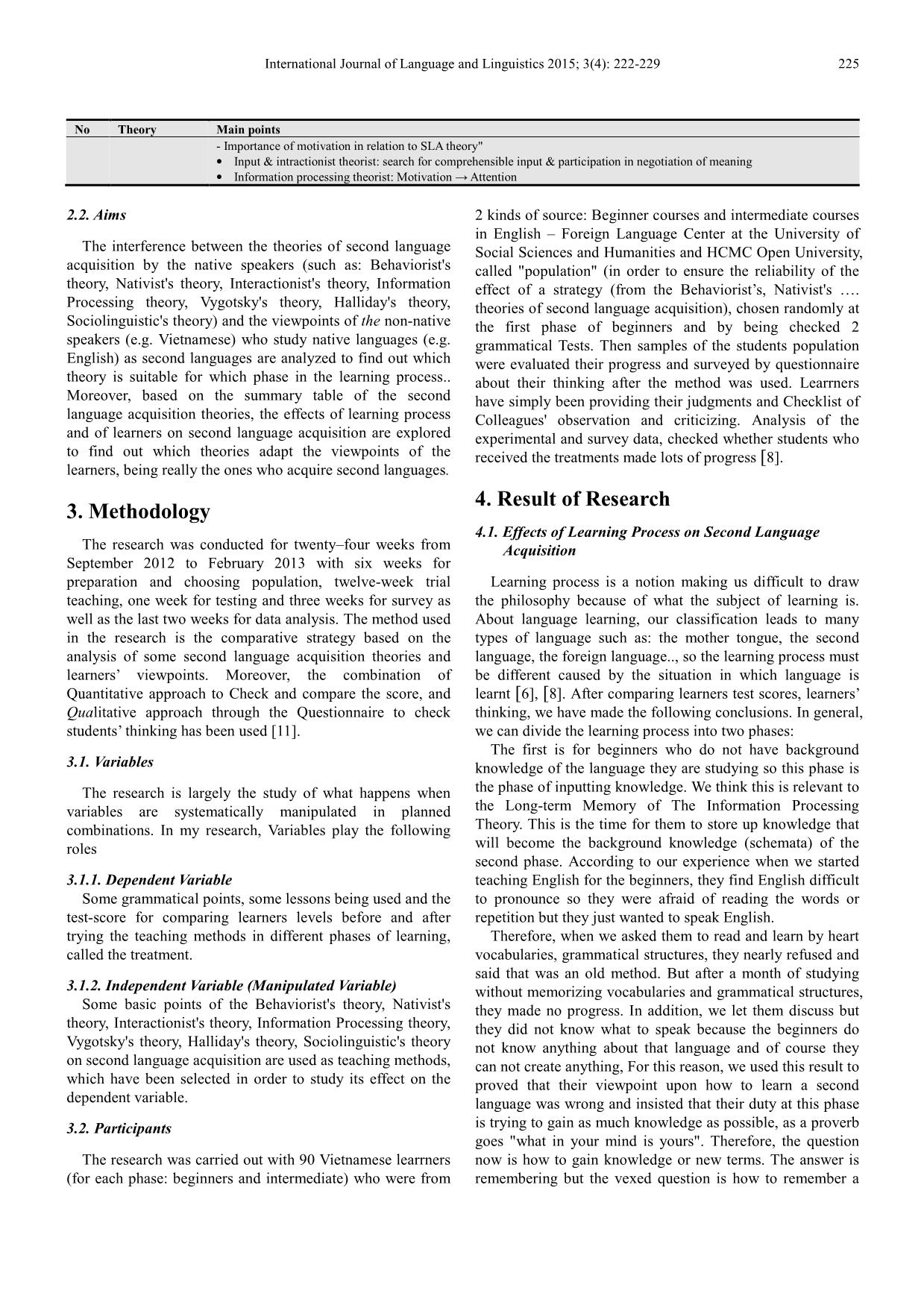
Trang 4

Trang 5
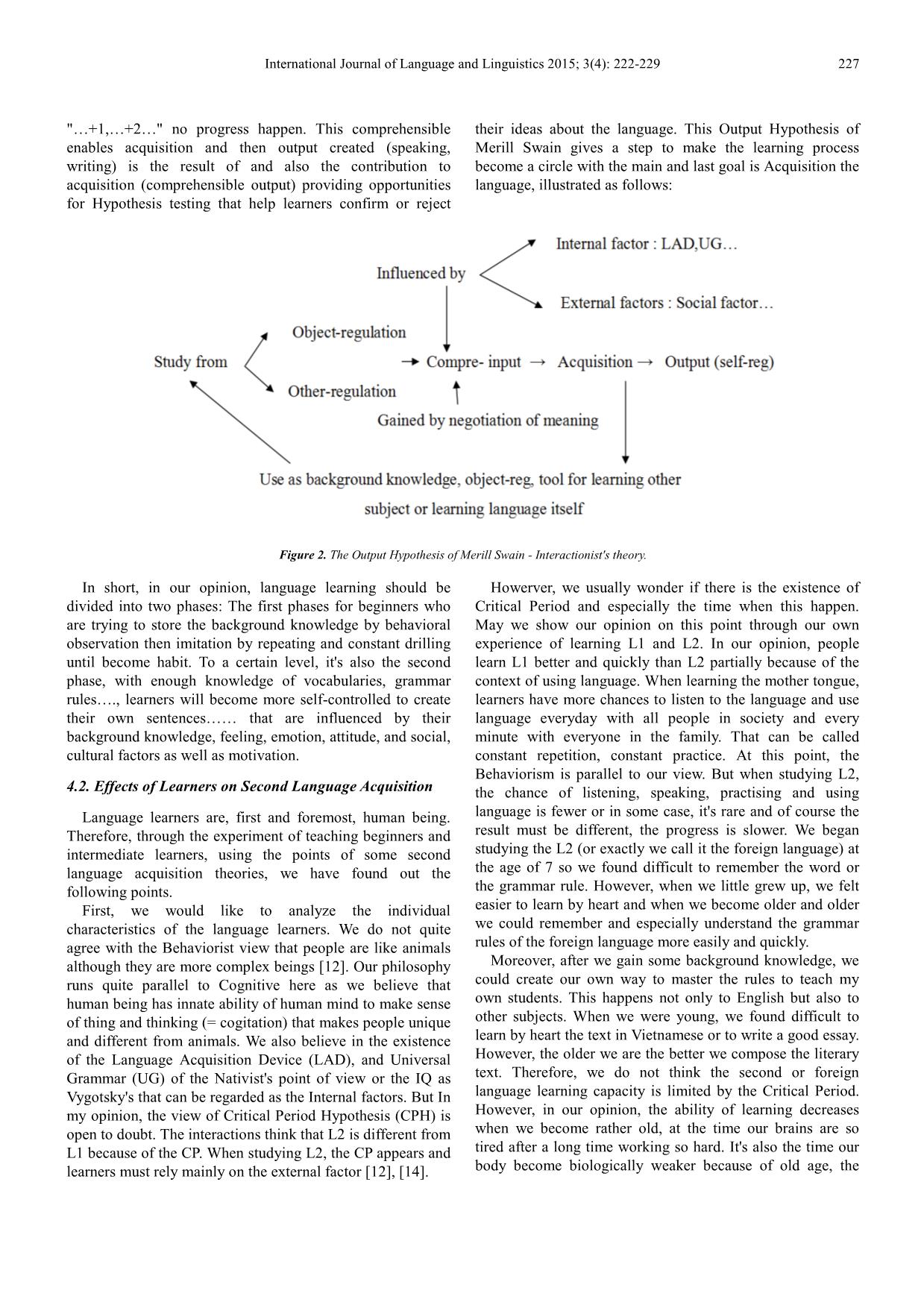
Trang 6
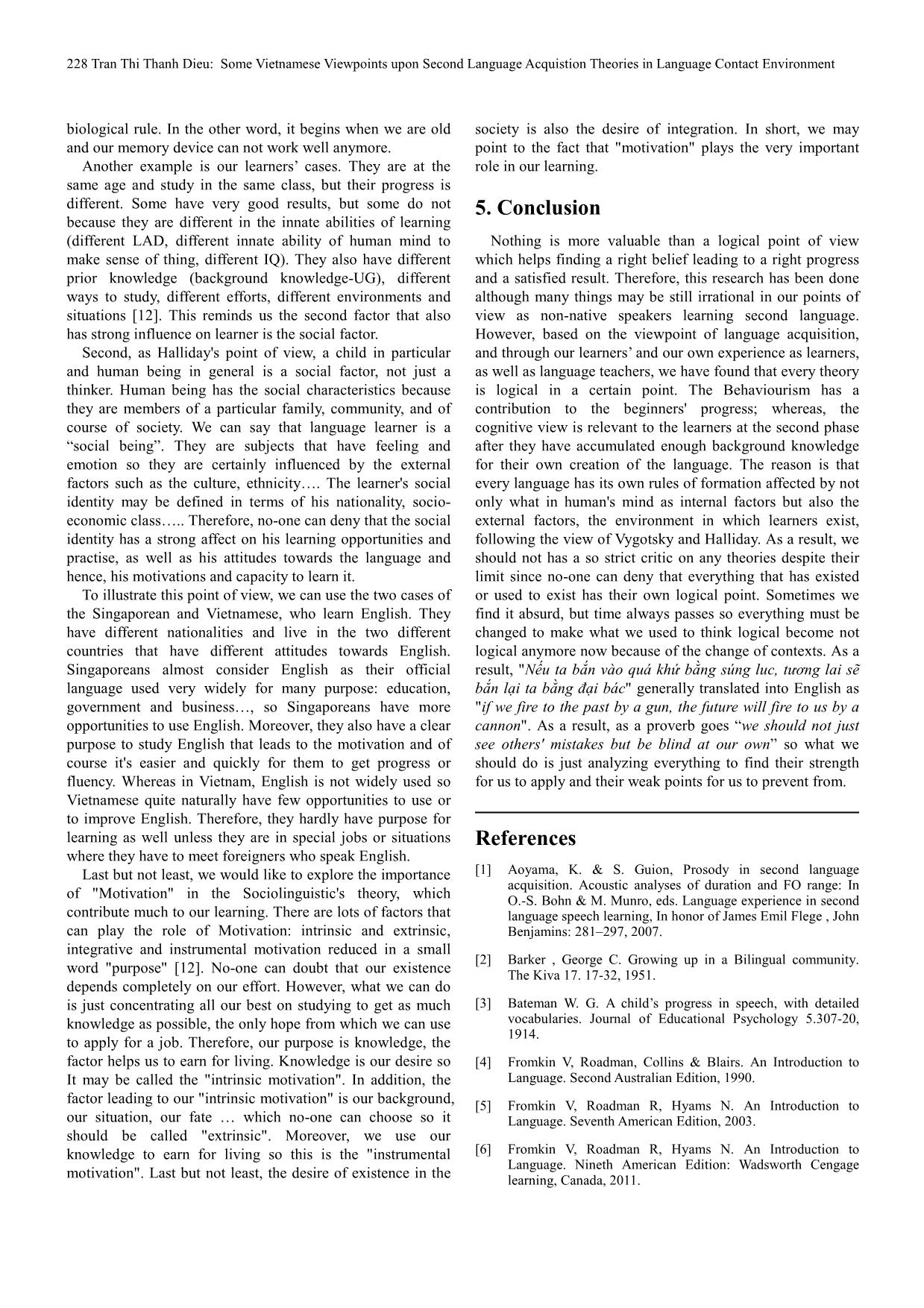
Trang 7

Trang 8
Tóm tắt nội dung tài liệu: Some Vietnamese Viewpoints upon Second Language Acquistion Theories in Language Contact Environment
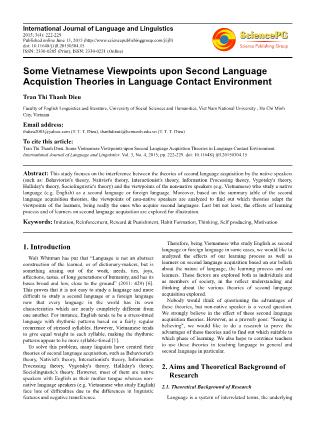
International Journal of Language and Linguistics 2015; 3(4): 222-229 Published online June 13, 2015 ( doi: 10.11648/j.ijll.20150304.15 ISSN: 2330-0205 (Print); ISSN: 2330-0221 (Online) Some Vietnamese Viewpoints upon Second Language Acquistion Theories in Language Contact Environment Tran Thi Thanh Dieu Faculty of English Linguistics and literature, University of Social Sciences and Humanities, Viet Nam National University , Ho Chí Minh City, Vietnam Email address: thdieu2003@yahoo.com (T. T. T. Dieu), thanhdieutt@hcmussh.edu.vn (T. T. T. Dieu) To cite this article: Tran Thi Thanh Dieu. Some Vietnamese Viewpoints upon Second Language Acquistion Theories in Language Contact Environment. International Journal of Language and Linguistics. Vol. 3, No. 4, 2015, pp. 222-229. doi: 10.11648/j.ijll.20150304.15 Abstract: This study focuses on the interference between the theories of second language acquisition by the native speakers (such as: Behaviorist's theory, Nativist's theory, Interactionist's theory, Information Processing theory, Vygotsky's theory, Halliday's theory, Sociolinguistic's theory) and the viewpoints of the non-native speakers (e.g. Vietnamese) who study a native language (e.g. English) as a second language or foreign language. Moreover, based on the summary table of the second language acquisition theories, the viewpoints of non-native speakers are analyzed to find out which theories adapt the viewpoints of the learners, being really the ones who acquire second languages. Last but not least, the effects of learning process and of learners on second language acquisition are explored for illustration. Keywords: Imitation, Reinforcement, Reward & Punishment, Habit Formation, Thinking, Self producing, Motivation 1. Introduction Walt Whitman has put that “Language is not an abstract construction of the learned, or of dictionary-makers, but is something arising out of the work, needs, ties, joys, affections, tastes, of long generations of humanity, and has its bases broad and low, close to the ground” (2011: 429) [6]. This proves that it is not easy to study a language and more difficult to study a second language or a foreign language now that every language in the world has its own characteristics which are nearly completely different from one another. For instance, English tends to be a stress-timed language with rhythmic patterns based on a fairly regular recurrence of stressed syllables. However, Vietnamese tends to give equal weight to each syllable, making the rhythmic patterns appear to be more syllable-timed [1]. To solve this problem, many linguists have created their theories of second language acquisition, such as Behaviorist's theory, Nativist's theory, Interactionist's theory, Information Processing theory, Vygotsky's theory, Halliday's theory, Sociolinguistic's theory. However, most of them are native speakers with English as their mother tongue whereas non- native language speakers (e.g. Vietnamese who study English) face lots of difficulties due to the differences in linguistic features and negative transference. Therefore, being Vietnamese who study English as second language or foreign language in some cases, we would like to analyzed the effects of our learning process as well as learners on second language acquisition based on our beliefs about the nature of language, the learning process and our learners. These factors are explored both as individuals and as members of society, in the reflect understanding and thinking about the various theories of second language acquisition explored. Nobody would think of questioning the advantages of these theories, but non-native speaker is a vexed question. We strongly believe in the effect of these second language acquisition theories. However, as a proverb goes: "Seeing is believing", we would like to do a research to prove the advantages of these theories and to find out which suitable to which phase of learning. We also hope to convince teachers to use these theories in teaching language in general and second language in particular. 2. Aims and Theoretical Background of Research 2.1. Theoretical Background of Research Language is a system of interrelated terms, the underlying International Journal of Language and Linguistics 2015; 3(4): 222-229 223 code which ensures that people can speak and understand each other [4]. It has social underpinning and is an operative system embedded in brain of everyone who has learnt a given language. This system is a network of relationships which characterized as being of the two kinds: "syntagmatic" (i.e. items are arranged in the consecutive, linear order) and associative, later termed "paradigmatic" (i.e. the organization of units in a deeper fashion dealing with grammatical and semantic relations) [6]. Language is emphasized as a system of (arbitrary signs and the central part of overall science of sign relations or semiotics (following CS. Peirce's terminology). Language as socio-semiotic presents language as functioning as an expression of and metaphor for, the social processes which it creates and the social contexts in which it occurs. Inherent in the socio-semiotic approach to language description is the notion of language as a dynamic process. In the other words, language is a system of recourse (consisting of first, the simultaneous lexico-grammar (words and grammar) which has three aspects consisting of transitivity (things, even, circumstance, mood (structure, elements, theme-rheme, cohesion) and second, the generic structure of text) to make the three simultaneous meaning (consisting of idealtional-representing experience and logic as well as interpersonal-exchanging information and goods- and-services, expressing position and textual-organising the flow of information) in context. Th ... Zone of proximal Development (ZPD) of Vygotsky’s philosophy to check the result of learning process [12]. We are also in favour of the view about the difference between ‘learning process’ and ‘acquisition process’. Learning process is a more conscious process, but acquisition process is subconscious. Many people have the same learning process because they are studying in the same class, for instance, our students, but they have the different acquisition process because of different of innate ability of learning (different LAD-different innate ability of human mind to make sense of things- different IQ), different prior knowledge (background knowledge-UG), different way to study, different effort, different environment & situation. And I think this is also the reason why there are many objects to homework [12]. They say that if the pupils are given the same homework but they do the homework in different situation, for instance, one does the homework in a very comfortable room with air-conditioning but the other must do the homework in a small house in a labour-area with noise, how can we compare the result and does the result really reflect the learners ability or quality? We can see the importance of the situation in this case. If we live in a place where people use that language in communication, the progress will happen faster and more easily. For instance, the immigrants from Vietnam, we usually call them "the Vietnamese oversea", when they live in Vietnam they spoke English very badly, but since they came to America to live they have been able to speak much better. Therefore, communication or interaction is an important factor to gain input through Negotiation of meaning of Michael Long's Interaction Hypothesis with many strategy such as: comprehension check, Confirmation check, Classification request, Request for repetition, self repetition or paraphrase [12]. About the result of learning process, we find something logical in the Imput hypothesis of Nativist philosophy [14]. Comprehensible input must be i+1, i+2. i+3.Because "i" is something like prior or background knowledge, without International Journal of Language and Linguistics 2015; 3(4): 222-229 227 "+1,+2" no progress happen. This comprehensible enables acquisition and then output created (speaking, writing) is the result of and also the contribution to acquisition (comprehensible output) providing opportunities for Hypothesis testing that help learners confirm or reject their ideas about the language. This Output Hypothesis of Merill Swain gives a step to make the learning process become a circle with the main and last goal is Acquisition the language, illustrated as follows: Figure 2. The Output Hypothesis of Merill Swain - Interactionist's theory. In short, in our opinion, language learning should be divided into two phases: The first phases for beginners who are trying to store the background knowledge by behavioral observation then imitation by repeating and constant drilling until become habit. To a certain level, it's also the second phase, with enough knowledge of vocabularies, grammar rules., learners will become more self-controlled to create their own sentences that are influenced by their background knowledge, feeling, emotion, attitude, and social, cultural factors as well as motivation. 4.2. Effects of Learners on Second Language Acquisition Language learners are, first and foremost, human being. Therefore, through the experiment of teaching beginners and intermediate learners, using the points of some second language acquisition theories, we have found out the following points. First, we would like to analyze the individual characteristics of the language learners. We do not quite agree with the Behaviorist view that people are like animals although they are more complex beings [12]. Our philosophy runs quite parallel to Cognitive here as we believe that human being has innate ability of human mind to make sense of thing and thinking (= cogitation) that makes people unique and different from animals. We also believe in the existence of the Language Acquisition Device (LAD), and Universal Grammar (UG) of the Nativist's point of view or the IQ as Vygotsky's that can be regarded as the Internal factors. But In my opinion, the view of Critical Period Hypothesis (CPH) is open to doubt. The interactions think that L2 is different from L1 because of the CP. When studying L2, the CP appears and learners must rely mainly on the external factor [12], [14]. Howerver, we usually wonder if there is the existence of Critical Period and especially the time when this happen. May we show our opinion on this point through our own experience of learning L1 and L2. In our opinion, people learn L1 better and quickly than L2 partially because of the context of using language. When learning the mother tongue, learners have more chances to listen to the language and use language everyday with all people in society and every minute with everyone in the family. That can be called constant repetition, constant practice. At this point, the Behaviorism is parallel to our view. But when studying L2, the chance of listening, speaking, practising and using language is fewer or in some case, it's rare and of course the result must be different, the progress is slower. We began studying the L2 (or exactly we call it the foreign language) at the age of 7 so we found difficult to remember the word or the grammar rule. However, when we little grew up, we felt easier to learn by heart and when we become older and older we could remember and especially understand the grammar rules of the foreign language more easily and quickly. Moreover, after we gain some background knowledge, we could create our own way to master the rules to teach my own students. This happens not only to English but also to other subjects. When we were young, we found difficult to learn by heart the text in Vietnamese or to write a good essay. However, the older we are the better we compose the literary text. Therefore, we do not think the second or foreign language learning capacity is limited by the Critical Period. However, in our opinion, the ability of learning decreases when we become rather old, at the time our brains are so tired after a long time working so hard. It's also the time our body become biologically weaker because of old age, the 228 Tran Thi Thanh Dieu: Some Vietnamese Viewpoints upon Second Language Acquistion Theories in Language Contact Environment biological rule. In the other word, it begins when we are old and our memory device can not work well anymore. Another example is our learners’ cases. They are at the same age and study in the same class, but their progress is different. Some have very good results, but some do not because they are different in the innate abilities of learning (different LAD, different innate ability of human mind to make sense of thing, different IQ). They also have different prior knowledge (background knowledge-UG), different ways to study, different efforts, different environments and situations [12]. This reminds us the second factor that also has strong influence on learner is the social factor. Second, as Halliday's point of view, a child in particular and human being in general is a social factor, not just a thinker. Human being has the social characteristics because they are members of a particular family, community, and of course of society. We can say that language learner is a “social being”. They are subjects that have feeling and emotion so they are certainly influenced by the external factors such as the culture, ethnicity. The learner's social identity may be defined in terms of his nationality, socio- economic class.. Therefore, no-one can deny that the social identity has a strong affect on his learning opportunities and practise, as well as his attitudes towards the language and hence, his motivations and capacity to learn it. To illustrate this point of view, we can use the two cases of the Singaporean and Vietnamese, who learn English. They have different nationalities and live in the two different countries that have different attitudes towards English. Singaporeans almost consider English as their official language used very widely for many purpose: education, government and business, so Singaporeans have more opportunities to use English. Moreover, they also have a clear purpose to study English that leads to the motivation and of course it's easier and quickly for them to get progress or fluency. Whereas in Vietnam, English is not widely used so Vietnamese quite naturally have few opportunities to use or to improve English. Therefore, they hardly have purpose for learning as well unless they are in special jobs or situations where they have to meet foreigners who speak English. Last but not least, we would like to explore the importance of "Motivation" in the Sociolinguistic's theory, which contribute much to our learning. There are lots of factors that can play the role of Motivation: intrinsic and extrinsic, integrative and instrumental motivation reduced in a small word "purpose" [12]. No-one can doubt that our existence depends completely on our effort. However, what we can do is just concentrating all our best on studying to get as much knowledge as possible, the only hope from which we can use to apply for a job. Therefore, our purpose is knowledge, the factor helps us to earn for living. Knowledge is our desire so It may be called the "intrinsic motivation". In addition, the factor leading to our "intrinsic motivation" is our background, our situation, our fate which no-one can choose so it should be called "extrinsic". Moreover, we use our knowledge to earn for living so this is the "instrumental motivation". Last but not least, the desire of existence in the society is also the desire of integration. In short, we may point to the fact that "motivation" plays the very important role in our learning. 5. Conclusion Nothing is more valuable than a logical point of view which helps finding a right belief leading to a right progress and a satisfied result. Therefore, this research has been done although many things may be still irrational in our points of view as non-native speakers learning second language. However, based on the viewpoint of language acquisition, and through our learners’ and our own experience as learners, as well as language teachers, we have found that every theory is logical in a certain point. The Behaviourism has a contribution to the beginners' progress; whereas, the cognitive view is relevant to the learners at the second phase after they have accumulated enough background knowledge for their own creation of the language. The reason is that every language has its own rules of formation affected by not only what in human's mind as internal factors but also the external factors, the environment in which learners exist, following the view of Vygotsky and Halliday. As a result, we should not has a so strict critic on any theories despite their limit since no-one can deny that everything that has existed or used to exist has their own logical point. Sometimes we find it absurd, but time always passes so everything must be changed to make what we used to think logical become not logical anymore now because of the change of contexts. As a result, "Nếu ta bắn vào quá khứ bằng súng luc, tương lai sẽ bắn lại ta bằng đại bác" generally translated into English as "if we fire to the past by a gun, the future will fire to us by a cannon". As a result, as a proverb goes “we should not just see others' mistakes but be blind at our own” so what we should do is just analyzing everything to find their strength for us to apply and their weak points for us to prevent from. References [1] Aoyama, K. & S. Guion, Prosody in second language acquisition. Acoustic analyses of duration and FO range: In O.-S. Bohn & M. Munro, eds. Language experience in second language speech learning, In honor of James Emil Flege , John Benjamins: 281–297, 2007. [2] Barker , George C. Growing up in a Bilingual community. The Kiva 17. 17-32, 1951. [3] Bateman W. G. A child’s progress in speech, with detailed vocabularies. Journal of Educational Psychology 5.307-20, 1914. [4] Fromkin V, Roadman, Collins & Blairs. An Introduction to Language. Second Australian Edition, 1990. [5] Fromkin V, Roadman R, Hyams N. An Introduction to Language. Seventh American Edition, 2003. [6] Fromkin V, Roadman R, Hyams N. An Introduction to Language. Nineth American Edition: Wadsworth Cengage learning, Canada, 2011. International Journal of Language and Linguistics 2015; 3(4): 222-229 229 [7] Nguyễn Thiện Giáp, Các phương pháp nghiên cứu ngôn ngữ. Nxb Giáo dục, 2009. [8] Hadley G. Action Research in Action: Singapore: SEAMEO Regional Language Center, 2003. [9] Kent Bach & Robert Hamish M. Linguistic Communication and Speech Acts. Mltpress, 1979. [10] Phạm Ngọc, Phạm Đức Dương, Tiếp xúc Ngôn ngữ ở Đông Nam Á. Viện Đông Nam Á, Hà Nội, 1983. [11] SEAMEO Regional Language Center, Research Methodology. Singapore: SEAMEO Regional Language Center, 2003. [12] Seameo Regional language Center - Singapore, Language Acquisition. Social & Psychological Dimension: SEAMEO, 2003. [13] Bùi Khánh Thế, Lý thuyết tiếp xúc ngôn ngữ và vấn đề tiếp xúc ngôn ngữ ở Việt Nam. Cơ sở Đào tạo Sau đại học – Viện Khoa học Xã hội tại TP. Hồ Chí Minh, 1997. [14] Uriel Weinreich, Language in contact: Findings and problems. Newyork, 1953.
File đính kèm:
 some_vietnamese_viewpoints_upon_second_language_acquistion_t.pdf
some_vietnamese_viewpoints_upon_second_language_acquistion_t.pdf

